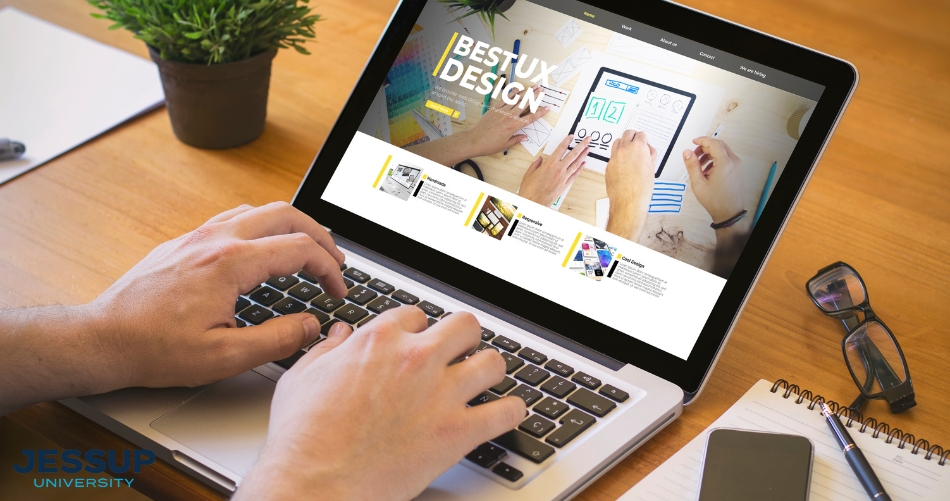Web Design London Ontario with SEO and Responsive Design
Web Design London Ontario with SEO and Responsive Design
Blog Article
How to Effectively Combine Aesthetic Appeals and Performance in Web Layout
When creating a web site, you need to strike a balance in between visual appeals and performance. It's not nearly looking good; your layout should likewise serve an objective and guide users efficiently. By focusing on simpleness and intuitive navigating, you can create an engaging experience. What components truly improve usability while keeping visual appeal? Allow's explore the key principles that can bring about an unified blend of charm and function.
Understanding the Relevance of Looks and Functionality
When you make an internet site, recognizing the balance between looks and performance is important for creating an effective individual experience. An aesthetically enticing site grabs attention, but it's the capability that maintains users involved. Site visitors will rapidly lose interest and leave.Consider your target audience and what attracts them in if your website looks wonderful yet is tough to browse. You wish to create a style that mirrors your brand while making certain simplicity of use. Structured designs, intuitive navigating, and clear telephone calls to activity can boost both visual appeals and capability.

Principles of Effective Website Design
To create a reliable internet layout, you require to follow a number of vital principles that improve both individual experience and visual appeal. Focus on simpleness; a tidy layout aids users browse easily. Utilize a consistent shade scheme and typography to preserve coherence across your site. This cultivates familiarity and trust.Next, assure your design is responsive. Customers access internet sites on different tools, so your design needs to adapt flawlessly. Take notice of aesthetic pecking order; highlight vital components with positioning, size, or color to lead individuals' focus.Finally, include sufficient white area. It prevents mess and makes material more absorbable. Remember, reliable website design balances appearances and performance, so every style option need to offer an objective. By following these principles, you'll create a site that's not only visually appealing but also easy to use, eventually maintaining visitors engaged and urging them to return.
Prioritizing User Experience
When focusing on customer experience, you'll want to start by recognizing what your customers truly require. Streamlining navigating style can make a significant distinction in exactly how quickly they discover what they're trying to find. Improving visual pecking order helps guide their focus to the most crucial components on your website.
Recognizing Individual Requirements
Comprehending individual needs is vital for creating an engaging internet experience that maintains visitors returning. To attain this, you have to determine the objectives and choices of your target market. Beginning by performing individual research study, like meetings or studies, to gather insights on what users value most. Take notice of their pain points and challenges when communicating with comparable web sites. This info permits you to tailor your design, making certain performance straightens with user expectations. In addition, think about creating individual identities that stand for various segments of your audience, assisting you picture their demands during the style procedure. When you focus on understanding user requirements, you develop a website that not only looks wonderful however additionally delivers a seamless, satisfying experience that cultivates loyalty.
Simplifying Navigation Style

Enhancing Aesthetic Pecking Order
A strong aesthetic pecking order is important in directing users through your internet site and ensuring they engage with key content. To attain this, utilize size, shade, and spacing tactically. Make essential elements like headings larger and bolder than body text, attracting interest promptly. Use contrasting colors to highlight phone call to activity, encouraging clicks. In addition, utilize ample white room to different sections, making material digestible and inviting.Consider the flow of details; set up components realistically, leading customers' eyes from one point to the next. Usage visual cues, like arrowheads or lines, to direct focus. By prioritizing visual power structure, you improve individual experience and increase the chance of conversions, ensuring your website is both cosmetically pleasing and functionally efficient.
Shade Theory and Its Effect On Use
While selecting the best shades for your internet site may feel like a small detail, it significantly influences usability and customer experience. Shade influences exactly how users perceive info and can boost or hinder navigation. As an example, contrasting colors can help important components attract attention, making it simpler for visitors to locate what they need.Additionally, think about the psychology of colors: blue commonly motivates count on, while red develops urgency. Knowing your target market can assist your shade options, guaranteeing they reverberate well.Moreover, constant color design help build brand name identity, making your web site extra remarkable. Be careful-- also lots of colors can bewilder individuals. Stick to a minimal palette that matches your material and keeps clarity.Incorporating access is also important; verify your color mixes are friendly for those with visual disabilities. By attentively applying shade theory, you'll improve usability and produce a more engaging customer experience.
Typography: Balancing Style and Readability
Shade options set the phase for your site, however typography plays a just as essential role in improving user experience. You desire your text to connect clearly while additionally showing your brand name's personality. Begin by choosing typefaces that are not only eye-catching however likewise readable. Sans-serif typefaces often function well for electronic displays, as they're simpler to read at various sizes.Maintain a pecking order by utilizing various typeface sizes and weights; this guides customers through your web content effortlessly. Think about line spacing and letter spacing; also limited can irritate visitors, while as well loose can disrupt the flow. Limitation your typeface options to two or three to maintain the style cohesive.Finally, always check your typography across different tools and browsers. What looks great on one display may not on one more. Balancing style with readability guarantees that your message resonates, keeping your audience engaged and notified.
Responsive Style: Making Aesthetic Appeals Work on All Tools
To guarantee your website looks wonderful on any kind of tool, you'll need to accept responsive design principles. This technique assurances your website adapts to numerous display sizes, giving a perfect customer experience. Begin by utilizing liquid grids and flexible photos that scale perfectly. Instead of fixed dimensions, go with percents and family member devices, enabling your format to change dynamically.Next, carry out media questions in your CSS. These allow you use different styles based on gadget attributes, like screen width. By doing this, you can preserve aesthetic charm while ensuring functionality.Don' t ignore touch targets; make particular buttons and web links are easy to touch on smaller screens. Prioritize vital web content, so customers can quickly browse your website no matter their gadget. By concentrating on these components, you'll develop an appealing, aesthetically appealing experience that satisfies the demands of all users, whether they're on a smart device, tablet, or desktop computer .
Carrying Out Functionality Testing for Constant Enhancement
To improve your website design, you need to set clear use goals that line up with user requirements. By carrying out individual tests, you can gather beneficial feedback on just how actual people connect with your website. Analyzing these results will help you make notified improvements and develop a more efficient customer experience.
Defining Functionality Goals
While aesthetic appeals can attract users in, specifying usability goals is crucial for ensuring their experience stays smooth and gratifying. Beginning by recognizing what you want customers to accomplish on your site (website design london Ontario). Consider their jobs, habits, and needs. Are they trying to find details, making a purchase, or enrolling in a newsletter? Establish clear criteria to determine success, like task conclusion rates or time on job. Prioritize user-friendly navigation, available material, and receptive style to enhance functionality. Routinely review these objectives as customer assumptions advance. By specifying functionality objectives, you develop a framework for evaluating and boosting your website's efficiency. This emphasis on functionality not just increases customer satisfaction but likewise strengthens the overall effectiveness of your design
Conducting Individual Examinations
Performing customer examinations is essential for fine-tuning your website and ensuring it fulfills your audience's demands. Start by identifying your target customers and developing an examination strategy that outlines your purposes. Make use of a mix of quantitative and qualitative techniques, such as studies, interviews, and task-based observations, to gather extensive comments. Welcome individuals to navigate your website while you observe their communications and keep in mind any problems they run into. Motivate open discussion to catch their ideas and feelings regarding the layout and performance. Maintain sessions brief and focused, guaranteeing you cover key locations without overwhelming customers. Make sure to record all searchings for, as this information will be indispensable for making informed layout decisions that boost both looks and functionality.
Analyzing Test Outcomes
How can you effectively examine the outcomes of your usability examinations to drive continual improvement? Begin by categorizing feedback right into typical themes. Try to find patterns in user habits that highlight discomfort factors or locations for enhancement. Usage quantitative information, like job completion rates and time on job, to determine functionality objectively. Do not fail to remember to take into consideration qualitative insights from user remarks; they frequently reveal underlying problems that numbers can't show. Focus on one of the most impactful searchings for and develop workable items for your style team. Bear in mind, it has to do with repeating-- carry out modifications, then test once again. This cycle of screening, assessing, and refining assists you balance aesthetics and functionality, ensuring your web site fulfills customer needs successfully while maintaining aesthetic appeal.
Often Asked Questions
Just how Do I Select the Right Color Palette for My Website?
To select the right color scheme for your web site, consider your brand name's individuality, target market, and emotional impact (website design london Ontario). Usage shade psychology, create consistency, and assurance readability. Test combinations to see what resonates ideal with site visitors
What Devices Can Assist With Internet Style Aesthetic Appeals and Functionality?
You can utilize tools like Adobe XD, Figma, and Map out to enhance your web layout's aesthetics and capability. These platforms offer user-friendly user interfaces, collaboration functions, and pre-made templates to streamline your creative procedure and enhance your designs.
Just How Can I Include Animations Without Endangering Capability?
To website incorporate animations without endangering capability, focus on refined results that enhance user experience. Use CSS computer animations for smoother interactions, warranty fast lots times, and examination on numerous devices to keep performance while adding aesthetic allure.
What Are Common Errors to Prevent in Internet Layout Aesthetic Appeals?
When designing, stay clear of cluttered designs, inadequate shade options, and irregular fonts. Don't forget mobile responsiveness, as it can push away users. Verify your layout straightens with your brand name, developing a smooth experience that engages site visitors properly.
How Typically Should I Update My Website's Layout for Optimum Looks?
You need to update your website's style every 1-2 years to stay up to date with trends and preserve optimal aesthetic appeals. Regularly renewing visuals aids involve warranties and visitors your site continues to be attractive and user-friendly. When you create an internet site, comprehending the balance between appearances and capability is important for developing an effective customer experience. To produce a reliable web design, you require to stick to several vital concepts that boost both customer experience and aesthetic charm. Individuals accessibility websites on numerous devices, so your layout needs to adjust flawlessly. When focusing on customer experience, you'll want to begin by understanding what your customers truly need. Begin by conducting individual study, like surveys or meetings, to gather understandings on what users worth most.
Report this page